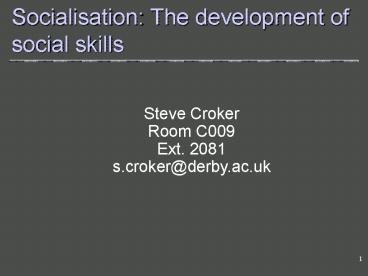Socialisation: The development of social skills - PowerPoint PPT Presentation
1 / 23
Title:
Socialisation: The development of social skills
Description:
what are the important influences in a child's life that affect how well they ... Good motor skills (Hops & Finch, 1985) Social skills. Influences : 2. Peers (2) 17 ... – PowerPoint PPT presentation
Number of Views:86
Avg rating:3.0/5.0
Title: Socialisation: The development of social skills
1
Socialisation The development of social skills
Steve Croker Room C009 Ext. 2081 s.croker_at_derby.ac
.uk
2
Outline
- What is socialisation
- Theories of social development
- Influences on social development
- Learning outcomes
3
What is socialisation?
- The development of social skills, attitudes and
behaviours - Social developmentalists ask
- how do these skills develop?
- what are the important influences in a child's
life that affect how well they develop
socialisation skills?
4
How do these skills develop?
- Three main theories
- Social learning theory
- parents are secondary reinforcers
- Psychoanalytic theories
- Freud parents satisfy biological needs
- Erikson parents satisfy social needs
- Ethological theory
- biological programming
5
Influences 1. Parents
- Bonding
- Attachment
- An enduring emotional tie that develops between
the infant and other significant people (Harris,
1993) - 4 phases(Ainsworth et al, 1978, Bowlby, 1984)
- No attachment (early years - about 0-5 months)
- Start of attachment (5-7 months)
- Separation Protest Fear of Strangers (7 months
- 3 yrs) - Goal corrected partnership (3 yrs )
6
Influences 1. Parents (2)
- Attachment (cont.)
- The Strange Situation experiment (Ainsworth and
colleagues) - Children were
- securely attached - 65 of sample
- insecure avoidant - 20
- Anxious/resistent ambivalent - 15
- disorganised/ disoriented - Main Soloman - 13
- Attachment style depends on parental sensitivity
- Implications of attachment style
7
From Messer Miller, 1999
8
(No Transcript)
9
(No Transcript)
10
(No Transcript)
11
(No Transcript)
12
(No Transcript)
13
Influences 1. Parents (3)
- Parenting Styles
- Baumrind (1967, 1971, 1980)
- 2 dimensions of parenting
- permissive-demanding dimension
- accepting/rejecting dimension
- 4 styles of parenting
- Accepting-permissive (Steinberg et al 1994)
- Accepting-demanding (Baumrind, 1991)
- Rejecting-permissive
- Rejecting-demanding (Weiss, Dodge, Bates and
Pettit, 1992)
14
From Dworetzky, 1996
15
Influences 2. Peers
- 3 months of age very first signs of social
awareness (Field, 1979, Fogel, 1979). - 6 months smiling, touching and lean at other
children (e.g Hay, Nash Pedersen, 1983). - Older babies crawl to one another (Vandell
Mueller, 1980). - 2 years start of proper interactions, become
more frequent and more complex as the children
age (Howes, 1987, Bronson, 1981).
16
Influences 2. Peers (2)
- 4 ways in which peers serve as socialisers
- As models
- As reinforcers
- Provide a secure environment
- Reflect the values of the larger society
- Peer popularity (deRosier, Kupersmidt,
Patterson, 1994) - Physical attractiveness
- Good motor skills (Hops Finch, 1985)
- Social skills
17
Influences 3. Siblings
- Relationship characterised by (Dunn, 1983)
- Uninhibited emotional quality (unlike in peers)
- Mutual interest in one another
- High frequency of interaction
- Attachment (Bernt Bulleit, 1985, Brody et al,
1985) - Aggression (Rafaelli, 1989)
- Influence on later development (Buhrmester
Furman, 1990) - Sibling rivalry (Abramovitch et al, 1982)
18
Influences 4. Grandparents
- Role they play depends on several factors
- family structure
- gender and age of child
- age of mother (Spieker Bensley, 1994).
19
Influences 5. Play
- Pleasurable, voluntary activity that involves
much repetition and variation as the child
explores the range of possibilities of behaviour
(Butterworth Harris, 1994). - Parton (1935) - social levels of play
- unoccupied play
- solitary play
- onlooker play increasing
- parallel play sociability
- associative play
- co-operative play
20
Influences 5. Play (2)
- Influence of play
- Howes Matheson (1992) greater social
comepetence - Furth Kiane (1992) allows children to gain a
greater understanding of their social environment - Influence of social pretend play or fantasy play
- Connolly et al develop awareness of others and
reciprocal relationships. - Connolly Doyle amount and complexity of social
fantasy play is significantly correlated with
social competence.
21
Influences 6. Culture
- Importance of most desirable behaviour
- attachment differences
- Importance of physical environment
- Whiting Edwards (1988)
- Kenya and Liberia rural villages
- Tarong community in Philappines
22
Influences 7. The child
- Temperament and attachment
- Kagan, 1984
- van Ijzendoorn deWolff, 1997
23
Learning outcomes
- Describe what socialisation is
- Describe and evaluate theories of socialisation
- Describe and evaluate the impact of different
influences on the development of social skills































